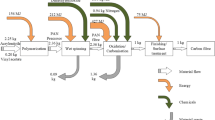Abstract
This is a study on the loading spectrum for full-scale fatigue testing of composite aircraft structures. Fatigue tests are performed to confirm the durability and damage tolerance of a composite aircraft structure. In particular, as composite materials have fatigue life variance larger than that of metallic materials, it takes a considerable amount of time to complete the aforementioned tests. Investigation of key factors such as spectrum truncation and load enhancement is required to create a load spectrum that can reasonably shorten the test time. In other words, criteria for removing the loads that have little effect on the fatigue life and applying factors for the severe load spectrum should be studied to produce the optimal load spectrum, which depends on the fatigue characteristics of the composite material. In this study, coupon tests and statistical analyses of carbon fiber/epoxy composites were performed to analyze the key elements and establish the criteria for the reliable truncation level and load factor for an optimal loading spectrum.




















Similar content being viewed by others
References
Broek D, Smith SH, Rice RC (1991) Generation of spectra and stress histories for fatigue and damage tolerance analysis of fuselage repair, DOT-VNTSC-FAA-91-16, pp 8–15
CMH-17-3G (2002) Composite materials handbook, vol 3, pp 64–100
Joo YS, Lee WJ, Seo BH, Lim SG (2019) A study on statistical characteristics of fatigue life of carbon fiber composite. JKSAS 47(1):35–40
Joo YS, Lim SG (2018) Evaluation of fatigue life and properties in composite material. In: KIMST conference proceedings
Sendeckyj GP (1981) Fitting models to composite materials fatigue data. ASTM STP 734:245–260
Kawai M, Koizumi M (2007) Nonlinear constants fatigue life diagrams for carbon/epoxy laminates at room temperature. Composites Part A:2342–2353
Nyman T, Ansell H, Blom A (2000) Effects of truncation and elimination on composite fatigue life. Compos Struct 48:275–286
Badaliance B, Dill HD, Blom A (1981) Effects of fighter attack spectrum on composite fatigue life. Air Force Wright Aeronautical Laboratory, AFWAL-TR-81-3001
(2015) Airbus Composite Fatigue and Damage Tolerance certification experience. In: FAA/Bombardier Composite Transport DT & Maintenance Workshop
Joo YS, Lim SG (2019) A study on fatigue properties of composite material based on PFA. In: KIMST conference proceedings
Acknowledgements
This work was supported by the Agency for Defense Development. We would like to thank Editage (www.editage.co.kr) for English language editing.
Author information
Authors and Affiliations
Corresponding author
Additional information
Publisher's Note
Springer Nature remains neutral with regard to jurisdictional claims in published maps and institutional affiliations.
Rights and permissions
About this article
Cite this article
Joo, YS., Lee, WJ., Seo, BH. et al. Introduction of Developing Fatigue Load Spectrum for Full-Scale Fatigue Test of Composite Aircraft. Int. J. Aeronaut. Space Sci. 21, 681–692 (2020). https://doi.org/10.1007/s42405-020-00257-8
Received:
Revised:
Accepted:
Published:
Issue Date:
DOI: https://doi.org/10.1007/s42405-020-00257-8




